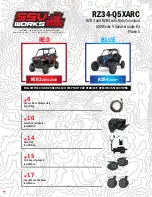
L-ACOUSTICS MTD Manual V1.2 11/30/2004
44
binoculars can provide a good starting point by simply measuring the distance from the delay location
to the main system, i.e., the geometric path difference.
5.5.3 COMPLEMENTARY FILL
For large-scale sound reinforcement (typically when V-DOSC, dV-DOSC or ARCS are used as the
main FOH system), MTD enclosures can be used for distributed front fill (ground stacked), flown
center cluster downfill, stereo in-fill, offstage fill or as distributed delays. The number of potential uses
for MTD108a, MTD112b or MTD115b enclosures for fill applications is only limited by your
imagination.
In all cases, proper time alignment of fill systems with respect to the main L/R FOH system is essential
for obtaining optimum results. Similarly, pre-delay to time align the overall sound reinforcement
system (main L/R FOH plus fill systems) with the energy generated on stage is also an important
consideration, particularly for the first 10 rows of the audience. WINMLS, SMAART or SPECTRAFOO
are cost-effective measurement tools for performing time alignment that are recommended.
FLOWN CENTER CLUSTER
Due to their compact size, point source behavior and generous coverage, MTD enclosures are highly
suitable for center cluster applications. Typically this will be necessary when the stage opening is wide
and the main left/right FOH system separation is greater than 20 meters. Apart from coverage issues,
image localization is an important consideration (particularly for theatrical installations) and careful
time alignment plus level balancing can significantly improve subjective localization for the audience to
the onstage performers. The trim height and tilt of an MTD center cluster fill system will depend on
the distance to the first rows of the audience area and, of course, on the height of the proscenium
opening.
DISTRIBUTED FRONT FILL
As an alternative (or complement) to a flown center cluster, MTD enclosures can be stacked on top of
a central line array of subwoofers (or any other object of suitable height) provided that the height of
the HF section is appropriate for audience coverage. Typically, a stacked height of at least 1-2 meters
is recommended in order to reduce audience shadowing effects and whether the audience is seated
or standing should be considered. In addition to these issues, sightlines and clearance under the stage
lip are also important considerations for a distributed front fill system and when space is at a premium,
the MTD108a provides an excellent solution.
As for overhead distributed or delay systems, the optimum spacing between MTD enclosures will
depend on the coverage angle of the enclosure (100, 85 and 85 degrees for MTD108a, MTD112b and
MTD115b, respectively) and the distance to the first members of the audience. Center-to-center
overlap will provide the most uniform coverage and separate time alignment delay taps for front fill
enclosures can further assist in improving image localization.
STEREO INFILL
Stacked stereo infill systems using MTD enclosures either located onstage or stacked on top of L/R
ground stacked subwoofer arrays can also be effective for front fill purposes. It is always a good idea
to keep MTD enclosures physically as close as possible to the subwoofers in order to improve sonic
integration between the fill system and the subwoofers plus to reduce low frequency proximity effects
for the audience located close to the subwoofers (i.e., it’s good to give the audience some high end to
help offset all that sub energy!). For smaller set designs, it can also be an option to place stereo front-
fill MTD enclosures close to the onstage side-fill monitoring system.
As for distributed front fill applications, the height of the HF section should be optimized to suit the
audience seating area in order to reduce shadowing effects. Special attention should be paid to the
first few rows and typically, a stacked height of at least 1-2 meters is recommended. If possible, use
distance-attenuation loss to your advantage and try to move MTD enclosures as far upstage as
Содержание MTD Series
Страница 1: ...Version 1 2 December 2004 L ACOUSTICS MTD LINE MTD108a MTD112b MTD115b OPERATOR MANUAL ...
Страница 3: ...L ACOUSTICS MTD Manual V1 2 11 30 2004 2 ...
Страница 11: ...L ACOUSTICS MTD Manual V1 2 11 30 2004 10 MTD108 LLCa front MTD108 LLCa rear LLC112b st front LLC112b st rear ...
Страница 58: ...L ACOUSTICS MTD Manual V1 2 30 11 04 57 Figure 30 MTD108a line drawing ...
Страница 59: ...L ACOUSTICS MTD Manual V1 2 30 11 04 58 Figure 31 MTD108a plus ETR8 line drawings ...
Страница 62: ...L ACOUSTICS MTD Manual V1 2 30 11 04 61 Figure 32 MTD112b line drawing ...
Страница 63: ...L ACOUSTICS MTD Manual V1 2 30 11 04 62 Figure 33 MTD112b plus ETR1 line drawings ...
Страница 66: ...L ACOUSTICS MTD Manual V1 2 30 11 04 65 Figure 34 MTD115b line drawing ...
Страница 67: ...L ACOUSTICS MTD Manual V1 2 30 11 04 66 Figure 35 MTD115b plus ETR2 line drawings ...
















































